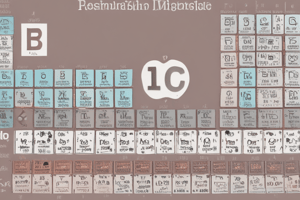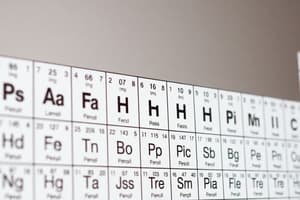Podcast
Questions and Answers
Which of the following statements accurately describes the Law of Triads?
Which of the following statements accurately describes the Law of Triads?
- It indicates that every third element has similar properties.
- It organizes elements based on increasing atomic weight.
- The middle element's properties are similar to the first and last elements.
- The middle element's properties are the average of the first and third elements. (correct)
What was a major contribution of Mendeleev to the periodic table?
What was a major contribution of Mendeleev to the periodic table?
- He grouped elements solely based on their density.
- He arranged the elements by atomic number instead of atomic mass.
- He was the first to publish a periodic table. (correct)
- He created a table without blanks for predicted elements.
According to Henry Moseley's revision, what should be the basis for arranging elements in the periodic table?
According to Henry Moseley's revision, what should be the basis for arranging elements in the periodic table?
- Increasing atomic number. (correct)
- Increasing atomic volume.
- The density of the elements.
- Increasing atomic mass.
What was the issue with the original periodic table proposed by Mendeleev?
What was the issue with the original periodic table proposed by Mendeleev?
Which of the following describes the Law of Octaves as proposed by Newlands?
Which of the following describes the Law of Octaves as proposed by Newlands?
Which two scientists contributed similarly to the development of the periodic table?
Which two scientists contributed similarly to the development of the periodic table?
Which of the following best describes the periodic law proposed by Mendeleev and Meyer?
Which of the following best describes the periodic law proposed by Mendeleev and Meyer?
Which of the following components is NOT typically included in the periodic table?
Which of the following components is NOT typically included in the periodic table?
Which of the following best describes the trend in atomic radius as you move from top to bottom in a group on the periodic table?
Which of the following best describes the trend in atomic radius as you move from top to bottom in a group on the periodic table?
How does the electron configuration relate to the chemical properties of elements in the same group?
How does the electron configuration relate to the chemical properties of elements in the same group?
Which group in the periodic table contains the elements known as noble gases?
Which group in the periodic table contains the elements known as noble gases?
Which block of the periodic table consists of transition metals?
Which block of the periodic table consists of transition metals?
What happens to the ionization energy as you move from left to right across a period?
What happens to the ionization energy as you move from left to right across a period?
Which periodic trend describes an element's ability to attract bonding electrons?
Which periodic trend describes an element's ability to attract bonding electrons?
In the periodic table, which group is characterized by having one valence electron?
In the periodic table, which group is characterized by having one valence electron?
What is the primary reason for the decrease in atomic radius as you move from left to right across a period?
What is the primary reason for the decrease in atomic radius as you move from left to right across a period?
What is the primary factor influencing the decrease in ionization energy between Groups IIA and IIIA?
What is the primary factor influencing the decrease in ionization energy between Groups IIA and IIIA?
Which statement correctly describes the trend in electron affinity across a period?
Which statement correctly describes the trend in electron affinity across a period?
What phenomenon occurs between Groups IA and IIA regarding electron affinity?
What phenomenon occurs between Groups IA and IIA regarding electron affinity?
How does electronegativity generally change in the periodic table?
How does electronegativity generally change in the periodic table?
What is the reason for the decrease in electron affinity as you move down a group?
What is the reason for the decrease in electron affinity as you move down a group?
Flashcards
Periodic Table
Periodic Table
A table that arranges all known elements in rows and columns based on their atomic properties.
Periodic Law (Mendeleev)
Periodic Law (Mendeleev)
Elements arranged by increasing atomic mass show repeating patterns of properties.
Mendeleev's Periodic Table
Mendeleev's Periodic Table
The first modern periodic table, predicting undiscovered elements.
Moseley's Periodic Law
Moseley's Periodic Law
Signup and view all the flashcards
Law of Triads
Law of Triads
Signup and view all the flashcards
Law of Octaves
Law of Octaves
Signup and view all the flashcards
Atomic Number
Atomic Number
Signup and view all the flashcards
Periodic Trends
Periodic Trends
Signup and view all the flashcards
Ionization Energy Trend (IIA - IIIA)
Ionization Energy Trend (IIA - IIIA)
Signup and view all the flashcards
Ionization Energy Trend (VA - VIA)
Ionization Energy Trend (VA - VIA)
Signup and view all the flashcards
Electron Affinity Trend: Top to Bottom
Electron Affinity Trend: Top to Bottom
Signup and view all the flashcards
Electron Affinity Trend: Left to Right
Electron Affinity Trend: Left to Right
Signup and view all the flashcards
Electron Affinity Discontinuity (IA - IIA)
Electron Affinity Discontinuity (IA - IIA)
Signup and view all the flashcards
Groups in the Periodic Table
Groups in the Periodic Table
Signup and view all the flashcards
Periods in the Periodic Table
Periods in the Periodic Table
Signup and view all the flashcards
Representative Elements
Representative Elements
Signup and view all the flashcards
Transition Metals
Transition Metals
Signup and view all the flashcards
s-block
s-block
Signup and view all the flashcards
p-block
p-block
Signup and view all the flashcards
d-block
d-block
Signup and view all the flashcards
f-block
f-block
Signup and view all the flashcards
Study Notes
Periodic Table
- List of all known elements
- Seven (7) rows and eighteen (18) columns
- Arrangement displays a pattern in atomic properties
Historical Development
- Johann Wolfgang Döbereiner
- John Alexander Reina Newlands
- Dmitri Ivanovich Mendeleev
- Julius Lothar Meyer
- Henry Gwyn Jeffreys Moseley
Law of Triads
- Middle element's properties are approximately the average of the other two
- Examples: Li, Na, K
Law of Octaves
- Eight musical notes analogy
- Elements with similar properties occur every 8 elements (in terms of increasing atomic weight)
- Key chemical principle - elements with similar physical and chemical properties occur after an interval of seven elements
Periodic Law
- When atoms are arranged by increasing atomic mass, atomic properties have a regular, repeating pattern
- Proposed by Mendeleev and Meyer
Dmitri Mendeleev
- Father of the Modern Periodic Table
- Arranged elements according to increasing atomic mass
Lothar Meyer
- Developed a similar periodic table scheme to Mendeleev, also based on atomic mass
- Used Atomic Volume measurements
Problem with Mendeleev's Periodic Table
- Two different elements could be in the same cell
- Example: Ar and Ca, Ar and K
Henry Moseley
- Revised the periodic law
- Elements arranged in increasing atomic number display regular patterns in their properties
Periodic Table Structure
- Vertical Columns: Represents groups/families of elements
- Horizontal Rows: Represents the element's period
- Group A: Representative elements
- Group B: Transition elements
Representative Elements
- 1A: Alkali metals
- 2A: Alkaline Earth metals
- 3A: Boron Family
- 4A: Carbon Group
- 5A: Nitrogen Group/Pnictogens
- 6A: Oxygen Group/Chalcogens
- 7A: Halogens
- 8A: Noble Gasses
Blocks of the Periodic Table
- s-block: Group 1A and 2A
- p-block: From boron group to noble gases (groups 3A to 8A)
- d-block: Transition metals
- f-block: Inner-transition metals
Electron Configuration and Periodic Table
- Elements in the same group/family have similar valence electron configurations, which lead to similar properties
Atomic Radius
- Defined as one-half the distance between covalently bonded nuclei
- Trend: Top to Bottom: Increases; Left to Right: Decreases
- Reason for trend: Top to Bottom: Energy level; Left to Right: Protons, increasing nuclear charge
Ionization Energy
- Energy needed to remove an electron
- Trend: Top to Bottom: Decreases; Left to Right: Increases
- Two 'jumps' in the trend due differences in shielding of valence electrons, etc
Electron Affinity
- Energy change when an electron is accepted to form an anion
- Trend: Top to Bottom: Decreases; Left to Right: Increases
Electronegativity
- The ability of an atom to attract electrons in a chemical bond
- Trend: Top to Bottom: Decreases; Left to Right: Increases
Motivating Exercises 1
- Match electron configuration to corresponding elements
Motivating Exercises 2
- Locate elements based on their group and period on the periodic table
Motivating Exercises 3
- Arrange elements in increasing atomic radius
Motivating Exercises 4
- Choose the largest ion within a specified group
- Given the ions listed, choose the largest
Motivating Exercises 5
- Arrange ions in order of increasing ionic size
- Ions listed
Ionic Size
- Depends on nuclear charge, number of electrons, and orbitals they reside
- Cations are smaller, anions are larger
- Isoelectronic series - ions have same number of electrons; size decrease with increasing nuclear charge
- More positive charge, smaller size; More negative charge, larger size
Studying That Suits You
Use AI to generate personalized quizzes and flashcards to suit your learning preferences.




